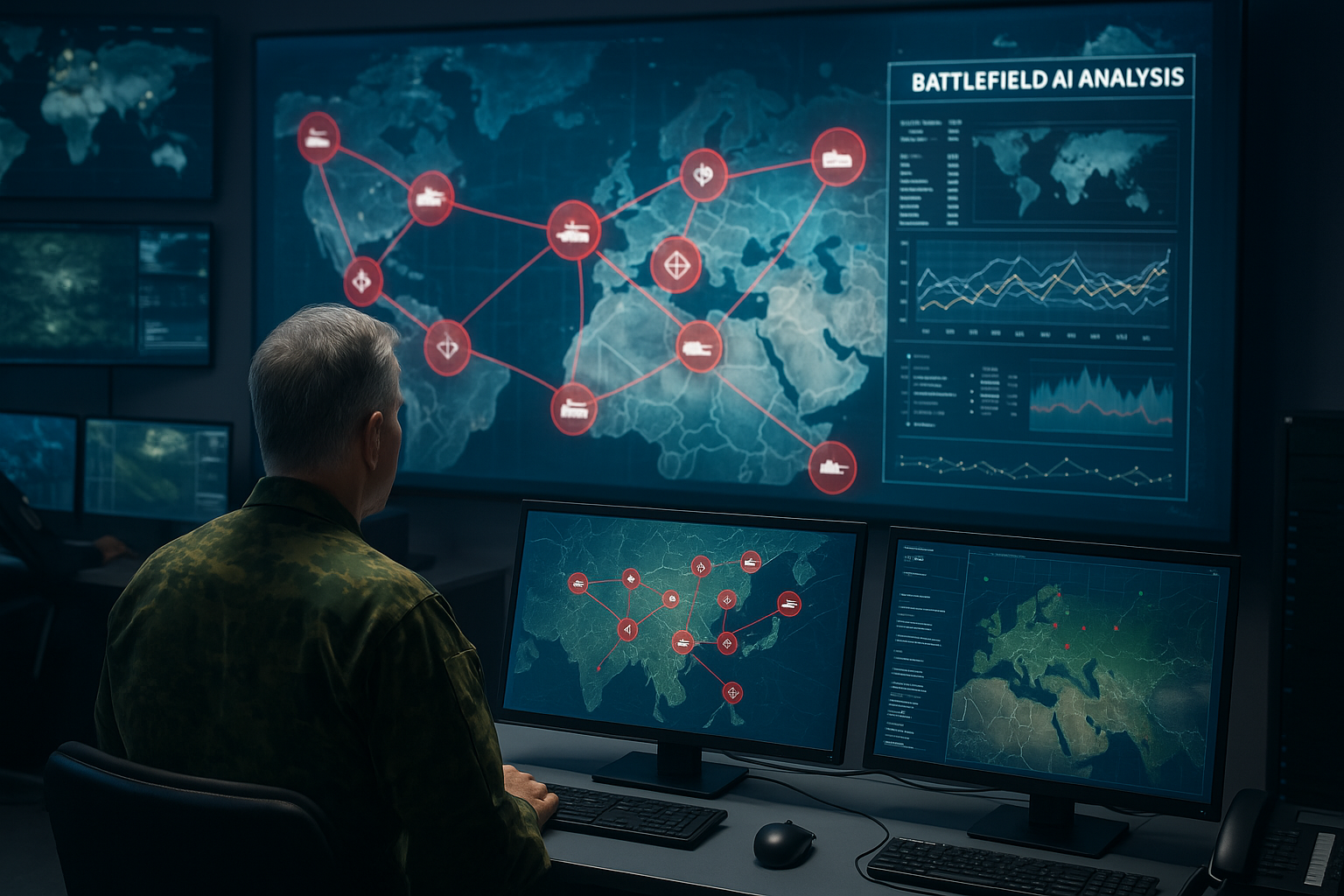Artificial intelligence is being used by many nations – in a different way than we imagine – an overview of developments
When I asked myself a year and a half ago where the use of AI in weapons systems would lead us, this idea still seemed abstract. After all, all the military forces claim to be sticking to the “human in the loop” concept. We think primarily of drones, the use of AI in target guidance systems and in fighter jets. The reality is different.
What sounded like science fiction back then is now reality – a reality that investors and entrepreneurs need to take seriously if they want to assess future opportunities and risks. It’s time to get an overview of specific initiatives in the various countries and draw concrete conclusions for future developments.
How the USA is using AI in the military sector today
In recent months, the US military has carried out extensive tests with generative AI systems for the first time. Around 2,500 marines from the 15th Marine Expeditionary Unit used AI on their missions in the Pacific to identify potential threats from a flood of public data in real time. AI was used to automatically translate and summarize foreign-language messages, and also assisted in the creation of daily situation reports. The tech company responsible, Vannevar Labs, was awarded a Pentagon contract worth 99 million dollars.
Despite the obvious advantages, such as the enormous increase in analysis speed, experts warn about critical sources of error in the AI technologies used. Particularly in the area of sentiment analysis – i.e. the recognition of sentiments and intentions in texts – misjudgements could have serious consequences. The difficulty of fully verifying AI spending is a key challenge and illustrates that the large-scale use of AI is not without risks. (Source: MIT Technology Review, 11.04.2025)
For investors, the USA offers a stable, established investment environment, which nevertheless entails numerous regulatory requirements due to its high degree of maturity. Dual-use technologies also very quickly fall under CFIUS or FOCI requirements.
Germany: concrete, but still plans
Germany is actively involved in the international race for military AI. With the “Uranos KI” project, the Bundeswehr is planning comprehensive AI-based surveillance of NATO’s eastern flank. The aim is to set up a digital command post that evaluates real-time data from drones, satellites and other reconnaissance systems. With an investment volume of around 80 million euros, it is clear that AI is also becoming a strategic priority in Germany.
Companies such as Airbus, Rheinmetall and ambitious start-ups such as Helsing are competing for the tender. In the future, AI will not only be used to analyze data, but also to support target detection and engagement. Although humans will remain the final decision-making authority for the time being, it remains to be seen how long this limit can actually be maintained. The first systems are set to be deployed in the Baltic states as early as 2026. (Quelle: Handelsblatt, 16.04.2025)
In Germany, many investors and entrepreneurs are seeing an opportunity in the promised windfall. However, the tenders and many requirements are a real risk in order to be able to assert oneself in the market, especially internationally (AWG, KWKG and many others).
What is happening in other countries
China is relying on specialized generative AI systems such as “ChatBIT” and “Aiwu LLM+”, which enable comprehensive information analysis and strategic decision support. AI-controlled drone swarms are already a reality here, underlining China’s seriousness and level of development in the field of AI warfare. The Chinese have secured the cooperation of Meta for their activities. A high-ranking Meta employee reports that Llama is being used strategically for the Chinese military AI tech stack. For Western investors, China’s strategic cooperation with Western companies such as Meta should be a clear warning signal: Technology partnerships are increasingly turning into decisions with geopolitically relevance.
Russia is currently focusing primarily on AI for autonomous drone operations in the Ukraine conflict. Despite intensive efforts in the field of deepfake technologies, no significant successes have yet been achieved in the field of generative AI. Nevertheless, these efforts underline Russia’s ambition to use AI in strategic conflicts in a targeted manner Source: Defense One, 2024). Russian troll factories have been masters of de-information campaigns for years. It can be assumed that AI is already being used here on a large scale. Commercial enterprises are also affected by this.
Israel has a big head start over other nations in the entire cyber security environment. Generative language models are primarily used for the rapid evaluation of Arabic-language intelligence information. Unit 8200 uses AI to extract potential threats from huge amounts of data, which also illustrates the opportunities and risks of data-driven military decisions. The Israeli lead shows how valuable consistent investment in AI research and close cooperation between the military, science and industry can be.
Europe and NATO, as a group, are the least concrete. Particular emphasis is placed here on the ethical and responsible use of AI. Numerous pilot projects on cyber defense and real-time situation analysis are already underway. NATO is currently working intensively on internationally binding standards for AI in the defense sector in order to set clear limits on technological development (Source: NATO Strategic Papers, 2024). Europe’s hesitant attitude towards military AI could become a further economic competitive disadvantage.
Challenges of military AI: Five theses
1. The illusion of “human-in-the-loop”
Increasingly complex AI systems are making it more and more difficult to achieve effective human control. The term “human-in-the-loop” suggests safety, but in practice it loses much of its meaning. In many scenarios, it is simply impossible for humans to fully check every single AI output. AI systems now generate so many data points and recommendations that humans could degenerate into mere observers who can no longer adequately check and understand decisions.
2. AI pushes the boundaries of information classification
With generative AI, a development is taking place in which previously irrelevant, unclassified information is suddenly combined into strategically important insights (classification by compilation). This calls existing secrecy models and information classifications (e.g. top secret, confidential) into question. It shows the need for a fundamental readjustment of existing systems in order to keep pace with the dynamics and capabilities of modern AI. Companies that develop technologies to protect or structure these new information networks could be among the big winners.
3. AI takes on strategic decision-making roles
AI systems used originally for support are increasingly taking on strategic functions. In the future, it could become commonplace for AI to independently make operational and strategic recommendations for action. As a result, human decision-makers will become increasingly dependent on AI recommendations, the origins of which are barely comprehensible. This raises considerable ethical and security policy questions. Together with point 5 – increasing asymmetry – the question is whether we can make progress by demanding rules and transparency, or whether it will be necessary to fully engage with AI systems as decision-makers in the future, especially to defend against attacks. Investors should particularly focus on AI start-ups that develop comprehensible and explainable models (explainable AI), as these will be decisive for the acceptance and success of the technology.
4. Escalating geopolitical risks through AI
Generative AI systems harbor considerable potential for escalation, especially in sensitive geopolitical analyses. AI-generated misjudgements, especially in the case of subtle signals or sentiment analyses, could have serious geopolitical consequences. Especially in tense crisis areas, misinterpretation by AI could increase tensions and even unintentionally lead to escalation.
In recent decades, diplomatic protocols have been established using slow human-based processes to reduce risks in escalation scenarios. Whether this can be transferred to AI systems is questionable. Larger companies also need to rethink their geopolitical risk management and use AI-based early warning systems and sentiment analysis to better anticipate risks.
5. AI makes military conflicts more asymmetrical
The widespread use of AI drastically reduces the costs and barriers for attacks and cyber operations. This shifts the strategic balance of power and enables smaller states and non-state actors to take increasingly disruptive actions. Traditional military powers are therefore increasingly facing asymmetric threats for which they are currently only prepared to a limited extent.
It can be assumed that multinational economic organizations such as corporations will also be able to carry out asymmetric attacks on states in the future. Companies are on their own here. In the past, states promised their citizens and companies that they and their territory would be protected. Today, companies have to take care of their own cyber defense. Strengthening their own defensive measures is essential, as AI-based attacks could not only affect military targets but also critical economic structures.
Conclusion
We still have no certainty as to how we can maintain control over these developments in the long term. Unlike nuclear weapons, AI technology is universally available – especially through open source models – and therefore almost impossible to control. Traditional solutions such as international treaties and sanctions no longer work here. This opens the door to completely new forms of terror and asymmetric conflicts.
Today, every company must invest in its own digital defense in order to position itself robustly against AI-driven attacks. At the same time, an enormous new growth area is emerging for investors and entrepreneurs: start-ups, technologies and services that develop innovative solutions for these new AI risks are on the verge of dynamic development and offer outstanding business potential.
Those who act now and invest in this future field will not only strengthen their own resilience, but also secure decisive competitive advantages in an increasingly complex and uncertain world.



